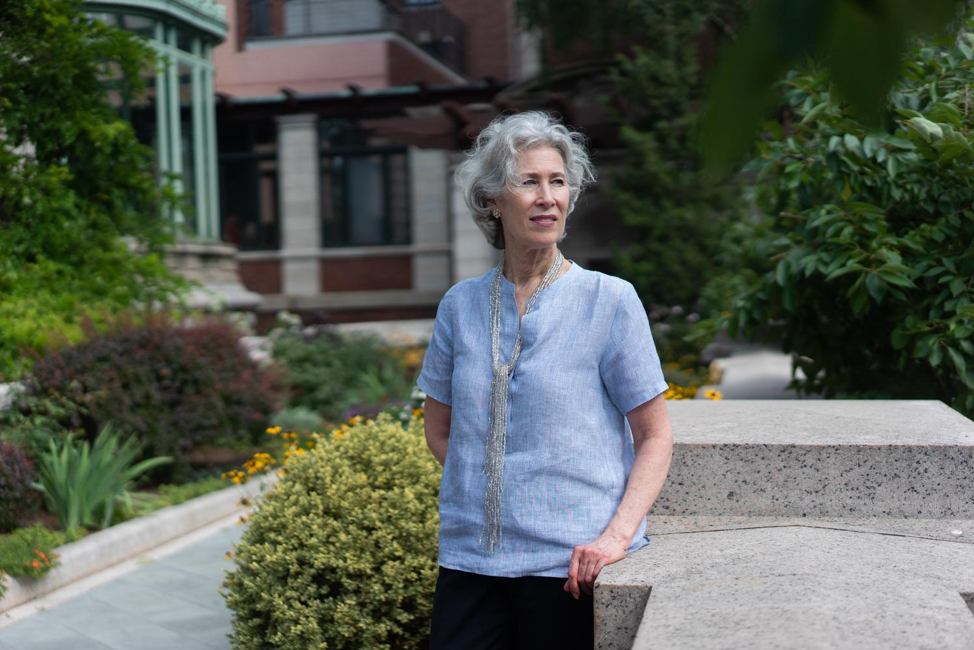This appraisal of Cara McCarty was contributed by Andrea Lipps, Associate Curator of Contemporary Design
Cara McCarty is a curator, lecturer, and writer on modern and contemporary design. Celebrated for her multidisciplinary approach to design, McCarty began her curatorial career in 1980 at the Museum of Modern Art (MoMA) where she held several curatorial positions. She initiated and curated many exhibitions with publications, including Mario Bellini: Designer (1987), Designs for Independent Living (1988), Information Art: Diagramming Microchips (1990), and Modern Masks and Helmets (1991). McCarty was a protégée of Arthur Drexler, the highly influential curator and director of MoMA’s Department of Architecture and Design. She wrote in 1987, “No individual deserves my deepest personal thanks more than Arthur Drexler… He taught me how to see.”[1]
McCarty has been described as a “conscientious collector.”[2] While at MoMA she developed a rigorous and self-assured eye, acquiring many key works including Sheila Hicks’s Evolving Tapestry, a Ballistic Mask, and a selection of Computer Chip diagrams. When collecting, McCarty considers how an object reflects the technology of its time. She looks for breakthrough pieces that represent an inflection point or “first.” She recognizes material and technical innovations. She notices the details.
In 1992, the St. Louis Museum of Art (SLAM) offered McCarty the opportunity to build a design collection. She moved from New York to St. Louis to head its Department of Decorative Arts and Design. McCarty intellectually shaped and built SLAM’s collection of late 19th to 21st-century design, acquiring over 400 works including key Japanese textiles and a long-lost screen for the Lambert-St. Louis Airport by Harry Bertoia.
While at SLAM, McCarty was involved in the museum’s expansion. She helped develop and participated in the architect selection process, and was actively involved in all aspects from the concept through design phases. She also curated a number of important exhibitions with publications, including Structure and Surface: Contemporary Japanese Textiles (1998), Masks: Faces of Culture (1999), and Tadao Ando: Architect (2001). Then in 2004, McCarty was awarded a prestigious Loeb Fellowship and spent an academic year at Harvard’s Graduate School of Design.
In 2007, McCarty returned to New York to become Curatorial Director at Cooper Hewitt, Smithsonian Design Museum. There, she oversaw the museum’s curatorial vision, collection, and exhibition planning, and curated exhibitions. McCarty was instrumental in Cooper Hewitt’s 2014 renovation and transformation into a 21st-century museum, from the master plan to the creation of immersive museum spaces and participatory visitor experiences. Among her celebrated exhibitions and publications are Why Design Now? National Design Triennial 2010 (2010), Tools: Extending Our Reach (2014), Access+Ability (2017)—which The New York Times said “makes plain why design matters” [3]—and The Road Ahead: Reimagining Mobility (2018). McCarty shaped the museum’s collection, adding strength to its American and contemporary holdings.

Access+Ability on view at Cooper Hewitt, Smithsonian Design Museum. Photo: Matt Flynn © Smithsonian Institution
Like Drexler, McCarty serves as a mentor to the next generation of design curators. She teaches them how to see. And through the stunning breadth of her exhibitions and collecting, McCarty interprets design broadly, an important legacy. As she describes it, “Design is a culturally creative act to solve everyday problems. Bad design wastes resources, demonstrates no cultural gain and has no positive consequence. Good design is both popular and profound at the same time, like Mozart’s piano concertos.” [4] And much like McCarty herself.
[1] Cara McCarty, Mario Bellini: Designer (New York: The Museum of Modern Art, 1987, 7.
[2] Susan Caba, “Conscientious Collector: Design curator Cara McCarty likes objects to solve problems, supply joy,” Stanford Magazine, July/August 2008, https://stanfordmag.org/contents/conscientious-collector.
[3] Michael Kimmelman, “Design for All: Products for people with disabilities were once uninspired. Not anymore,” The New York Times, January 26, 2018, https://www.nytimes.com/2018/01/24/arts/design/cooper-hewitt-access-ability.html.
[4] “Meet the Staff: Cara McCarty,” Cooper Hewitt, Smithsonian Design Museum, May 1, 2013, https://www.cooperhewitt.org/2013/05/01/meet-the-staff-cara-mccarty/.

5 thoughts on “Cara McCarty, Curator: An Astonishing Career”
Sheila Hicks on February 5, 2020 at 2:07 pm
Well deserved praise and appreciation of a heroic , creative curator.
Jeannine Falino on February 10, 2020 at 10:01 am
Congratulations on a stellar career and best wishes for the future!
Paul Thompson on February 11, 2020 at 6:49 am
Congratulations indeed Cara, and thank you for your wisdom, style, and commitment to Design.
Very best wishes
Paul Thompson
Al Eiber on March 17, 2020 at 4:53 pm
Congratulations Cara on a wonderful career. I have admired your eye since we fought over a Pesce Cirva glass piece many years ago. We both won as it is now at the Cooper Hewitt forever. Stay well and hope to see you soon.
Brendan W. Nolan, Esquire on October 26, 2022 at 8:24 pm
I have a small pitcher that I am willing to donate to Cooper Hewitt. If you would like to see a photo of same, please email me your email address. Thank you kindly!!!